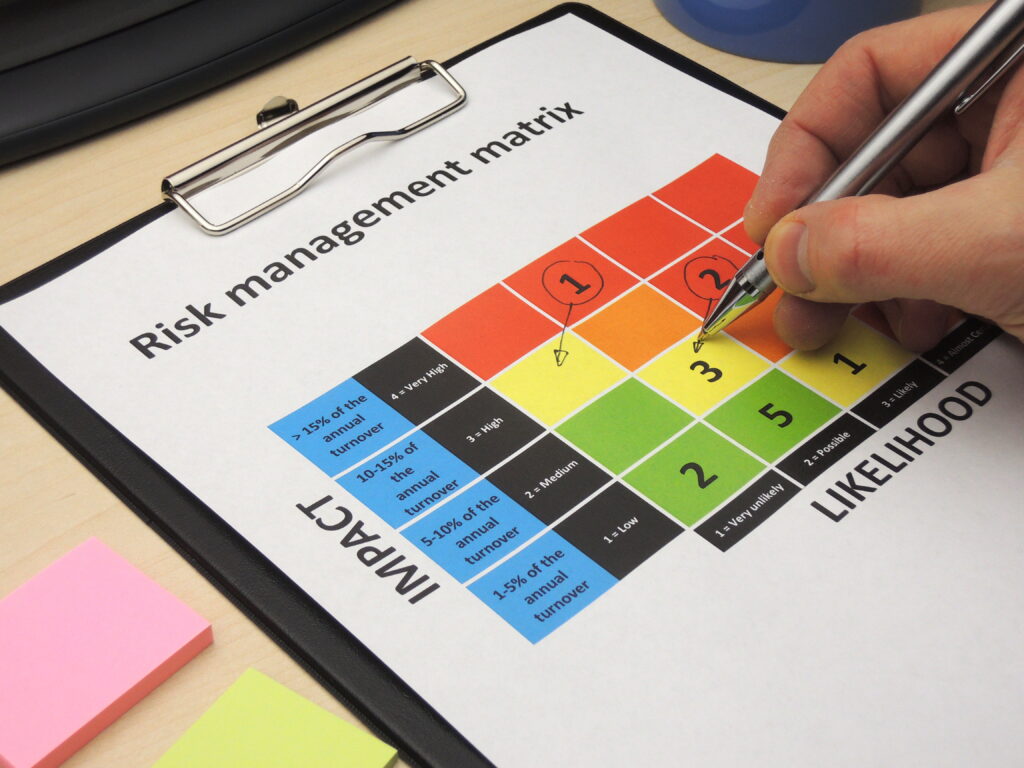By: Christina Olivarria
In the world of Transition and Activation project management, risks, and issues are terms that we encounter regularly. Even the most thought-out plans will almost certainly face unanticipated risks and issues. Necessary plan adjustments should come as no surprise to any industry professional. As we have welcomed advancements in technology and embraced the interconnectivity of strategic and dynamic partnerships, the project environment has become increasingly complex to navigate. Thus, teams need an effective method to manage risks and issues as they arise.
Before jumping into the how-to of managing risks and issues, it is important to understand the difference between the two terms. We often hear these two terms used interchangeably when, in fact, they have very distinct definitions. In the simplest terms, risks are events that have not occurred but may impact the project, whereas issues are unfavorable events that have occurred, whose effects must be assessed for impact on the project. Although both can ultimately influence a project, the management methodology is distinctly different.
Managing Project Risks
The Project Management Institute defines individual project risk as “an uncertain event or condition that, if it occurs, has a positive or negative effect on one or more project objectives.” During the project initiation phase, an assessment is conducted with key stakeholders to understand the project’s requirements, validate project scope, and identify any initial gaps in planning that could negatively impact the project’s objectives. At Yellow Brick, we believe that early identification of project threats and the continuous evaluation of risks enable organizations to develop well-planned risk responses. This approach promotes a collaborative environment that encourages transparent dialogue amongst teams.
On a Transition and Activation project, many factors influence project success. Over the course of activating more than 60 healthcare facilities across North America, we have identified three categories that consistently impact a project’s successful activation: the Transition and Activation schedule, budget, and resources.
Setting up a Risk Management Plan
- Establish Risk Measures: Establish risk scoring criteria with the project sponsor during the project initiation phase. Review each risk category’s scoring levels with the project sponsor and tailor the ranges to suit the organization’s risk tolerance. For example, an organization may be more tolerant of an increase in project resources but less tolerant of schedule shifting. Thus, the project manager would adjust the impact scoring to reflect the tolerance assumptions.
- Develop a Tracking Method: At Yellow Brick, we use a Risk Register to track and monitor project risks. We review the Risk Register with our client partners monthly. With the required meeting participants and the establishment of a risk review cadence, we ensure accurate and consistent reporting.
- Assess Impact and Probability: Evaluate each identified risk’s potential impact on the project and probability of occurrence. This assessment enables the organization to prioritize risks appropriately.
- Confirm Risk Response Strategy: Work with the project sponsor to determine the response strategy for each identified risk. Below is a summary of the most common risk response strategies:
- Avoid: The decision to take action to eliminate the cause of the risk to the project.
- Mitigate: The decision to take action to reduce the impact or the probability of the risk to the project.
- Transfer: The decision to take action to make another party responsible for the risk.
- Monitor: The decision not to act; instead, continue to evaluate the risk and act only when the risk becomes a higher threat to the project.

Managing Project Issues
Once the contractor hands over the keys to the facility, the organization assumes responsibility for the building’s maintenance and activities leading to activation. The Project Management Institute defines a project issue as “a current condition or situation that may have an impact on the project objectives.” Although it is a goal to have a facility turned over in pristine working order, the reality of projects is there are almost always items to address before Day 1 Activation. Thus, it is essential to establish a method to manage identified issues.
In Simplifying the Complex: A Guide to Transition and Activation Planning for Healthcare Construction Projects, Yellow Brick recommends establishing a process to identify, categorize, prioritize, and communicate identified issues. The organization should assign an individual to manage the Issues List, including designating an owner for each issue, setting due dates, tracking resolution, and providing performance metrics to organizational leadership.
Setting up an Issues Management Process
- Develop a Tracking Tool: A best practice is to use a web-based application to host the Issues List. We utilize Smartsheets at Yellow Brick, as it enables access by multiple users and real-time updates. Recommended Issues List columns include:
- Date Reported
- Issue ID #
- Issue Description
- Category
- Priority
- Department
- Location / Room #
- Reported by
- Contact Information
- Assigned to
- Updates
- Status
- Due Date
- Establish a Method to Report Issues: It is important to communicate the issues reporting method to team members. If using a web-based application, an electronic form can be developed to enable team members to submit issues. If unable to submit issues electronically, a paper issues form can be utilized. Issues forms should be readily available to team members, and submission guidelines communicated.
- Validate Issue Prioritization Criteria: An essential step in the issues management process is validating the criteria used to prioritize issues. Establishing a method to sort the “must-haves” from the “nice-to-haves” ensures that the issues management process is streamlined and objective. Yellow Brick recommends prioritizing issues based on the impact on staff and patient safety and regulatory compliance. Below is the example of issues prioritization:
- 1 – High Priority: Impact to patient or staff safety, or required for regulatory compliance. Patient or staff safety will be compromised if any “must-have” issues are missed. Issues that are not compliant with regulatory code.
- 2 – Medium Priority: Significant issue. “Should-have” issues present a considerable challenge to planned operations and should be resolved before Day 1 Activation.
- 3 – Low Priority: A “nice-to-have” issue poses no impact on staff or patient safety, and the facility can open without resolution.
Risk and Issue Management Best Practices
The reality is, even the most exacting project planners need to develop contingency plans for possible threats to project success that may arise throughout the project lifecycle. Project managers can leverage the following best practices to manage both risks and issues.
Plan Early
Part of the project initiation phase should include the establishment of both the risk and issues management process. Identify owners of each process and identify required resources. For the risk management process, identify potential risks during the initial assessment period and develop strategies with the project sponsor to respond appropriately.
Gain Leadership Buy-in
Buy-in from executive leadership teams is a key success element for risk and issues management. Clearly define their role, what they should expect, and how performance metrics will be shared. Early executive backing ensures the project team understands that assignments are priorities of the organization and that escalated items will be visible to the leadership team.
Communicate Effectively and Purposefully
Conversations regarding risks and issues can be challenging and uncomfortable. Establishing a cadence and reporting structure early increases transparency, normalizes difficult conversations, and encourages vital discussions to prevent the downstream effects on project success.
Create an Environment of Accountability
Assigning owners to identified risks and issues is the first step, but holding these designated owners accountable is an even more critical step. When setting ownership, ensure the identified individuals understand what they are responsible for and the due date. For risk management, owners must evaluate the need to enact risk response strategies should a risk be triggered. For issues management, owners need to report the resolution of issues by required dates. The project manager is ultimately accountable for both processes and ensures that teams feel supported and have what they need to be successful.
As you dive into your project, be sure to include risk and issues management processes in your overall project plan. There are dozens of templates available online. Ensure that the method you select suits the project you are managing. At Yellow Brick, our motto is to “simplify the complex” in all aspects of the project. We have found that including only the necessary items minimizes stakeholder confusion and ensures teams can focus on the mitigation and resolution of risks and issues.


